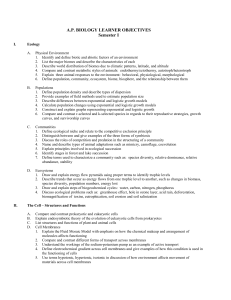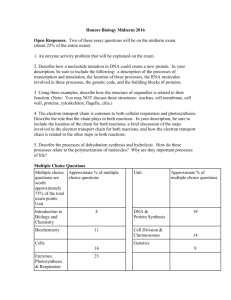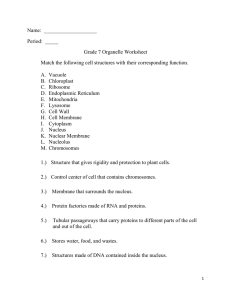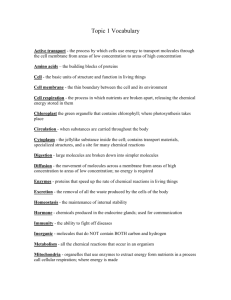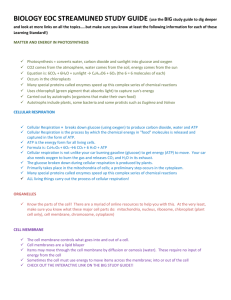Student Name: Teacher: Date: ______ District: Rutherford County
advertisement
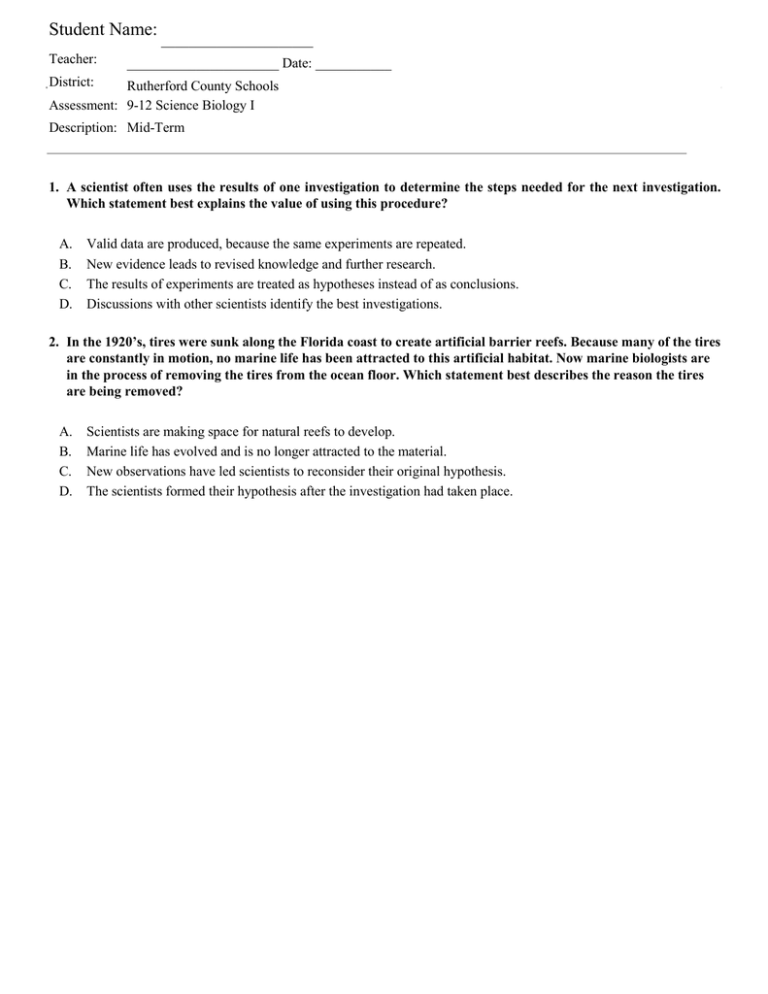
Student Name: Teacher: ______________________ ______________________ Date: ___________ District: Rutherford County Schools Assessment: 9-12 Science Biology I Description: Mid-Term 1. A scientist often uses the results of one investigation to determine the steps needed for the next investigation. Which statement best explains the value of using this procedure? A. B. C. D. Valid data are produced, because the same experiments are repeated. New evidence leads to revised knowledge and further research. The results of experiments are treated as hypotheses instead of as conclusions. Discussions with other scientists identify the best investigations. 2. In the 1920’s, tires were sunk along the Florida coast to create artificial barrier reefs. Because many of the tires are constantly in motion, no marine life has been attracted to this artificial habitat. Now marine biologists are in the process of removing the tires from the ocean floor. Which statement best describes the reason the tires are being removed? A. B. C. D. Scientists are making space for natural reefs to develop. Marine life has evolved and is no longer attracted to the material. New observations have led scientists to reconsider their original hypothesis. The scientists formed their hypothesis after the investigation had taken place. Identical amounts of potato slices were weighed and placed in beakers containing 50 mL of tap water. Sugar was added in different amounts to each beaker. 3. The potato slices were weighed again after 24 hours. The percent change in mass for the slices from each beaker was determined. Which is the independent (manipulated) variable in this investigation? A. B. C. D. the mass of the potato slices the temperature of the water the amount of water in each beaker the amount of sugar in each beaker 4. Sally noticed that there was a decline in the number of eggs her hens were laying. She decided to investigate if the decline might be caused by the amount of food she was feeding the hens. Which would be the dependent (responding) variable in Sally’s investigation? A. B. C. D. number of eggs laid size of the cage amount of food age of hens 5. Students conducted an investigation with green bananas. They hypothesized that an onion placed near a banana could increase the rate at which the banana ripened. They placed one onion and one banana in each of three containers. In a fourth container they placed a banana, but no onion. Which statement best explains why the onion was left out of the fourth container? A. B. C. D. The onion would contaminate the fourth trial. The container without the onion is the control. Three containers with onions are enough to conduct the test. The container without the onion is the independent variable. 6. Which set of tools would be best to use for dissecting in a biology lab? A. pen, paper, and a computer B. scissors, forceps, and a scalpel C. Petri dish, flask, and a Bunsen burner D. glass slides, dye, and a light microscope 7. What are petri dishes used for in a lab? A. reflecting light to form images B. measuring the mass of molecules C. growing bacteria in a controlled setting D. observing the strength of physical forces 8. A farmer wants to know which brand of fertilizer is the best to use for his crops. The farmer buys three different brands of fertilizer and uses them on three corn plants. The farmer uses the fertilizers for four weeks and finds one fertilizer helped the corn plants grow the fastest. The farmer chooses the fertilizer to use on all of his tomato plants. What should the farmer have done to make the experiment more reliable? A. B. C. D. The farmer should have used more corn plants. The farmer should have used the fertilizer for three weeks. The farmer should have used tomato plants instead of corn plants. The farmer should have used only two different brands of fertilizer. 9. A pharmaceutical company develops a new antibiotic to treat pneumonia. After limited testing, the researchers conclude that the antibiotic seems to be effective. How can the researchers strengthen their conclusions? A. B. C. D. Test the antibiotic on human volunteers. Publish their results in a medical journal. Ask an independent lab to retest the antibiotic. Test the effectiveness of the antibiotic at killing other bacteria. 10. A student hypothesized that the greater amount of insect biodiversity at a stream indicated a climax community. The student collected samples of insects from four different stream areas. The student created the pie graphs below that represent the number of insect species from each area. Based on the student’s hypothesis, which stream was most likely a climax community? A. B. C. D. 1 2 3 4 11. Lactose intolerance is a condition of the digestive system in which an individual has an inability to digest lactose, the sugar found in milk. An individual affected with lactose intolerance does not produce enough of the enzyme lactase, which is needed to break down lactose. If more adults than children are diagnosed with lactose intolerance, what does this most likely suggest? A. B. C. D. The production of lactase decreases over time. The digestion of food breaks down lactase. Lactose intolerance is an allergic reaction. Lactose intolerance is contagious. 12. In medical research, the “double blind method” is often used. Half of the participants receive the medicine and half receive a sugar pill. Neither the researcher nor the participants know who is receiving the medicine. The main reason the double blind method is used is that it A. B. C. D. confirms that the medicine produces a positive effect in the participants. ensures that the participants have a 50% chance of taking real medicine. helps eliminate bias both in the participants and in the researchers. reduces the dosage of medicine that each participant takes. A student was investigating the growth rate of a certain plant species. He planted three plants of the same species in separate pots. Each plant was grown under the same light source and received the same amount of water and fertilizer over a five-day period. His results are shown in the graph. 13. The student concluded that Plant 1 was grown in soil with fewer nutrients than the other two plants. Which is another acceptable explanation for the difference in the growth of the plants? A. B. C. D. Plant 1 had a fungus in the soil that prevented it from growing. Plants 2 and 3 were given a different type of fertilizer to grow. Plant 1 received mineral-enriched water that prevented its growth. Plants 2 and 3 were given growth hormone supplements. 14. A student performed an investigation on the relationship between respiration and photosynthesis. After one week, only the organisms in Jar 1 remained healthy. The student concluded that the environment in Jar 1 was the most stable because it contained living organisms. Which is the BEST alternate explanation for why Jar 1 is the most stable? A. B. C. D. The shells of the snails give off calcium that is needed by the plants. The plants are able to photosynthesize because they float away from the snails. The plants can use the snails as a source of energy. The plants and snails exchange gases necessary to survive. 15. NMR (nuclear magnetic resonance) is a technology that can observe the motion of individual atoms in a molecule. This technology has been used to analyze enzymes. Which aspect of enzymes is this technology most useful in researching? A. B. C. D. the genes that code for enzymes the chemical energy stored in enzymes the change in enzyme structure during binding with a substrate the benefits of being able to produce particular enzymes 16. Monique investigates whether light intensity affects the rate of photosynthesis in one type of plant. Monique created this graph based on her data. As light intensity increases, how is the rate of photosynthesis affected? A. B. C. D. It increases continuously. It decreases continuously. First it increases and then decreases. First it increases and then becomes constant. 17. Cardiac muscle cells have a higher concentration of mitochondria than skeletal muscle cells. What does the difference in mitochondrial concentration most likely indicate about cardiac muscle cells compared with skeletal muscle cells? A. B. C. D. Cardiac muscle cells have more structural proteins in their cytoplasm. Cardiac muscle cells are located farther from areas where lipids are stored. Cardiac muscle cells have a lower release rate of carbon dioxide into veins. Cardiac muscle cells require a larger supply of energy released through respiration. 18. Where are proteins synthesized? A. B. C. D. mitochondria ribosomes centrioles lysosomes 19. A researcher observes membrane-bound structures in a cell. Based on this observation, the researcher can conclude that the cell is classified as a A. B. C. D. bacterium. virus. prokaryote. eukaryote. 20. Which question would scientists studying prokaryotic organisms most likely ask? A. B. C. D. How do lysosomes expel bacteria from cells? What role does the nucleus play in stability? How do chloroplasts convert light into energy? Why are ribosomes efficient protein producers? 21. Proteins function to provide structure for tissues and organs. Which of the following are the building blocks of proteins? A. B. C. D. The diagram shows the structural formula for starch. 22. Which of the following explains why starch is a polymer? A. B. C. D. repetitive combination of simple subunits organic compound molecule high mobility as a result of its long length contains carbon-based functional groups 23. Which of these statements describes how monomers combine and create macromolecules? A. B. C. D. Amino acids combine to make proteins. Glucose molecules combine to make nucleic acids. Nucleic acids combine to make starch. Proteins combine to make glucose. 24. Pepsin is an enzyme that acts in the stomach for protein digestion. Which of these is most likely the main role of pepsin in this metabolic reaction? A. B. C. D. to speed up the rate of reaction to reduce the loss of energy as heat to control the direction of the reaction to protect the reaction from other chemicals Illustration 1 shows sugar that has formed a bond by the action of an enzyme. Illustration 2 shows the enzyme, and Illustration 3 shows the enzyme after the addition of heat. 25. How does the addition of heat affect the ability of an enzyme to help the sugar molecules form a bond? A. B. C. D. Heat allows the sugar molecules to bond more quickly. Heat provides places on the enzyme for other molecules to bond. Heat changes the enzyme so that the sugar molecules can no longer bond. Heat changes the chemical composition of the sugar molecules so they no longer need the enzyme. Catalase is an enzyme that speeds up the decomposition of hydrogen peroxide into water and oxygen. Students conducted two investigations to determine the ideal conditions for the function of catalase. One investigation compared catalase activity at different values of pH. The other investigation compared catalase activity at different temperatures. 26. According to the data in the chart, which pH and temperature combination provides the best conditions for catalase to function? A. B. C. D. pH 5 and 4°C pH 5 and 25°C pH 7 and 37°C pH 7 and 50°C 27. Biochemical reactions that require high temperatures to proceed are able to take place at body temperature within the cells of living organisms. Which factor is mainly responsible for allowing biochemical reactions to proceed at body temperature? A. B. C. D. The cellular enzymes act as catalysts. The small size of cells keeps reactants together. The pH of the cytoplasm increases reaction rate. The reactants are present in small quantities in the cell. Activation energy is required to begin a reaction. The graph shows a reaction with two different activation energies. 28. In each reaction, the temperature and concentration of the reactants was the same. Which best explains the reduction in the activation energy for Reaction 2? A. B. C. D. A catalyst was present during Reaction 2. The investigation was conducted closer to the heat source. Higher quality reactants were used during Reaction 1. A different type of glassware was used during Reaction 1. 29. Which term best describes the movement of water through cell membranes? A. B. C. D. respiration osmosis mitosis condensation 30. Which statement best explains what happens to a leaf when it has lost much-needed water? A. B. C. D. Its turgor pressure decreases. Its atmospheric pressure decreases. Its rate of transpiration increases. Its rate of photosynthesis increases. 31. Shira is analyzing samples of red blood cells using a microscope. Her observations are shown. Shira observes that the shape of Cell A appears normal, while Cell B appears swollen and Cell C is shrunken. The apparent shrinking of Cell C indicates the reaction of the cell to what? A. B. C. D. an anaerobic environment outside the cell lower solute concentration outside the cell than inside more oxygen inside the cell than what can be utilized higher solute concentration outside the cell than inside 32. Which cellular structure in an animal cell helps maintain homeostasis by controlling the transportation of substances into and out of the cell? A. B. C. D. vacuole cell wall mitochondrion cell membrane 33. What will happen to a cell that is placed in a hypotonic saline solution? A. B. C. D. Water will exit the cell causing it to shrink. Water will enter the cell causing it to swell. Salt will exit the cell causing it to shrink. Salt will enter the cell causing it to swell. 34. Each beaker shown below contains an amphibian egg collected from one of four different locations. Which of these beakers contains an egg that would shrink? A. B. C. D. 1 2 3 4 35. The diagram illustrates the movement of molecules through a cell membrane. What process is being used by the cell to move the molecules? A. B. C. D. osmosis endocytosis active transport facilitated diffusion 36. Cell membranes allow some molecules to move freely across the membrane, while other molecules are restricted. Which term best describes this capability of a cell membrane? A. B. C. D. Semi-permeable impervious resilient unyielding 37. The following reaction occurs in plants. This reaction is beneficial to plants because it A. B. C. D. Results in a net increase in the mass of the atoms. Produces chemical building blocks for proteins. Keeps ultraviolet light from damaging their cells. Provides chemical energy to the cells. 38. Living organisms and artificial devices both use and store energy with various methods and structures. Which of the following is most like a green leaf during the daytime? A. a person running along a track B. a solar collector charging a battery C. a person eating a hamburger at lunch time D. a wind turbine generating electric current as it spins 39. Living organisms require energy for biological processes. Chemical energy in a plant cell is A. B. C. D. 40. Produced in vacuoles. Converted from solar energy. Developed by centrioles. Stored as kinetic energy. Look at the diagram below of a biochemical reaction that occurs within cells. Which reaction is taking place between 1 and 3? A. B. C. D. ammonification glycolysis photosynthesis respiration Item 41 Directions: Students conducted an investigation using Biuret reagent to determine the presence of protein in different foods. The results are shown below. Test for Proteins SUBSTANCE COLOR AFTER ADDING BIURET Honey Blue Cottage Cheese Purple/lavender Potato Dark blue Water Light blue Chicken broth Dark purple Yogurt, plain Light purple 41. According to the data, which foods tested by the students contained protein? A. B. C. D. Honey and Potato Potato and Chicken broth Cottage cheese and Water Cottage cheese and Yogurt Item 42 Directions: A student test an unknown, colorless solution for the presence of sugars, starches, lipids, and proteins results are shown below. UNKNOWN SOLUTION RESULTS TESTING INDICATOR OBSERVATION Iodine Unknown solution turned from colorless to brown-orange Benedict’s Solution Unknown solution turned from colorless to orange Biuret Solution Unknown solution turned from colorless to purple Brown Paper Bag No mark left, unknown solution completely 42. Based on the data, collected, which molecules are present in the unknown solution? A. B. C. D. starches and lipids proteins and starches sugars and proteins lipids and proteins Item 3 Directions: A student tests an unknown colorless solution for the presence of sugars, starches, lipids and proteins. The results are shown in the table below. Testing Indicator Observation Iodine (Lugol's Solution) Unknown solution turned from colorless to bluish-black Benedict’s Solution Unknown solution turned from colorless to orange Biuret Solution Unknown solution turned from colorless to blue Sudan Unknown solution turned from colorless to light pink 43. Based on the data collected, which molecules are present in the unknown solution? A. B. C. D. starches and lipids proteins and starches sugars and starches lipids and proteins 44. A student uses Sudan III to test a 1-gram sample of an organic macromolecule. The solution turns dark red. What can the student conclude about the function of the macromolecule in a living organism? A. B. C. D. The macromolecule encodes information. The macromolecule stores energy for short periods. The macromolecule stores energy for long periods The macromolecule helps cells perform actions or maintain structure. Item 5 Directions: The table shows nine substances tested for biomolecules. Iodine Solution Benedicts Reagent Biuret Reagent Sudan IV Reagent Banana + + - - Applesauce - + - - Meat - - + slight Egg Yolk - - + - Cream - - + slight Flour + - - - Cornstarch + - - - Soaked Beans + - + - Table Sugar - + - - Substance 45. Which substance contains lipids and protein? A. B. C. D. 46. meat egg yolk soaked beans banana A substance produced during photosynthesis that is used for completion of cellular respiration is A. Water. C. NADPH. B. ATP. D. Oxygen. 47. The name of the process that takes place when organic compounds are broken down in the absence of oxygen is A. Respiration. C. Fermentation. B. Oxidation. D. All of the above 48. You have been growing some animal cells in culture. The cells grow well for several weeks, and then their growth slows down. You conduct some tests and determine that there is a lot of lactic acid in the culture fluid. Which of the following is the most likely explanation for the poor growth of the cells? A. There is too much glucose in the culture fluid. B. There is not enough glucose in the culture fluid. C. There is too much oxygen in the culture fluid. D. There is not enough oxygen in the culture fluid. 49. ATP molecules produced during aerobic respiration A. Remain in the mitochondria in which they are formed. B. Are stored in chloroplasts of the same cell in which they are formed. C. Enter the cell’s cytoplasm through the membranes of the mitochondria in which they are formed. D. Are distributed by the bloodstream to all cells in the body. 50. At the end of the electron transport chain, A. The electrons combine with oxygen and protons to form water. B. The electrons are used in the formation of ethyl alcohol. C. The electrons build up inside the mitochondria and diffuse back to a thylakoid. D. None of the above 51. When living cells break down molecules, energy is A. Stored as ADP. C. Released as heat. B. Stored as ATP. D. Both b and c 52. Which of the following is the best explanation for the presence of both chloroplasts and mitochondria in plant cells? A. In the light, plants are photosynthetic autotrophs. In the dark, they are heterotrophs. B. If plants cannot produce enough ATP in the process of photosynthesis to meet their energy needs, they can produce it in aerobic respiration. C. Sugars are produced in chloroplasts. These sugars can be stored in the plant for later use, converted to other chemicals, or broken down in aerobic respiration to yield ATP for the plant to use to meet its energy needs. D. The leaves and sometimes the stems of plants contain chloroplasts, which produce ATP to meet the energy needs of these plant parts. The roots of plants contain mitochondria, which produce ATP to meet the energy needs of these plant parts. 53. In cellular respiration, the most energy is transferred during A. Glycolysis. B. Lactic acid fermentation. C. The Krebs cycle. D. The electron transport chain 54. Electrons are donated to the electron transport chain by A. ATP and NADH. C. ATP and NAD+. B. FADH2 and NADH. D. NAD+ and ATP. 55. Chromatids are: A. Dense patches within the nucleus. B. Bacterial chromosomes. C. Duplicate halves of a chromosome. D. Prokaryotic nuclei. 56. Which of the following is not a true difference between the chromosomes of eukaryotes and those of prokaryotes? A. Eukaryotic chromosomes are linear, while those of prokaryotes are circular. B. Eukaryotic chromosomes are found free in the nucleus, while those of prokaryotes are located in the nucleoid C. Eukaryotes usually have more than one chromosome, while prokaryotes usually have only one chromosome. D. Eukaryotic chromosomes contain DNA, while prokaryotic chromosomes contain a different form of genetic material. 57. The chromosome of a bacterium A. Is wrapped around proteins. B. Has a circular shape. C. Occurs in multiple pairs within the cell. D. Is found within the nucleus. 58. A spindle fiber is a specialized form of A. Microtubule. C. Cilium. B. Flagellum. D. Chromosome. 59. A typical human cell contains 46 chromosomes. After mitosis and cytokinesis, each of the two new cells formed from the original cell A. Has 23 chromosomes. B. Grows new chromosomes from existing DNA. C. Has a complete set of 46 chromosomes. D None of the above 60. Refer to the illustration above. Which of the following correctly indicates the order in which these events occur? A. 1, 2, 3, 4 C. 2, 1, 3, 4 B. 3, 2, 1, 4 D. 1, 3, 2, 4

